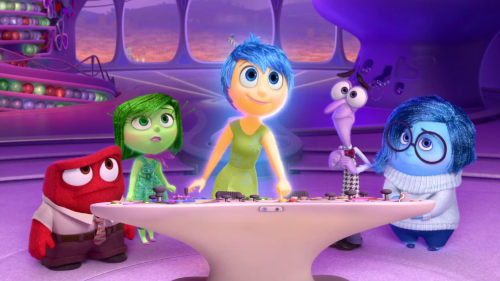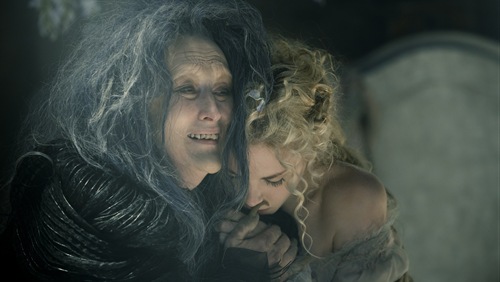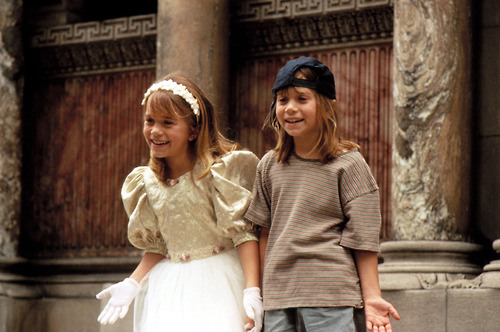(SPOILERS for Pixar’s Inside Out)
As pointed out by Natalie Wilson on Bitch Flicks, Pixar’s latest film, Inside Out, about a preteen girl and her characterized emotions, has plenty to enJoy. It’s a female-centric film, with three leading female protagonists – the 11-year-old Riley (voiced by Kaitlyn Dias), her leading emotion Joy (voiced by Amy Poehler), and Joy’s least favorite co-emotion, Sadness (voiced by Phyllis Smith). There are also many other female characters, such as Disgust (voiced by Mindy Kaling) and Riley’s best friend Meg (voiced by Paris Van Dyke), and unnamed but still important characters such as Riley’s mom (voiced by Diane Lane). So many female characters with leading or otherwise key roles in the story means that the Bechdel Test is passed in multiple scenes. Nevertheless, while there is much gender diversity, and to a lesser extent ethnic divsersity, there is much less diversity offscreen.
All four producers were men. Pete Docter and Ronaldo Del Carmen, a White man and a Man of Color, co-directed and came up with the story. Of the three people who wrote the screenplay, there was one woman (Meg LeFauve), and the music, film editing, and art direction were all done by men, and most of the rest of the crew is male. This is despite the fact that not only does the film feature many female characters, but most of the film actually takes place inside the mind of a girl. And yet, not only was the film mainly created by men, but even the scientific and psychological consultants who were brought on board to help Pixar create an accurate and authentic portrayal of the workings of a girl’s mind, were men. Sure, the daughters of the film’s creators provided the “inspiration” for the story, but it’s not their names on the film. It’s therefore unsurprising that the character who most drives the plot of the film is Riley’s dad (voiced by Kyle MacLachlan). In fact, the film is largely one big piece of advice for fathers from fathers.
Riley’s dad is the one who moves the family from Minnesota to San Francisco for the sake of his start-up business, and it is this move that is the impetus for the plot and the changes that take place in Riley. Though not portrayed as an actual villain, the film puts a fair amount of blame for Riley’s unhappiness on Riley’s mother. It is Riley’s mom who brings in the dad to reprimand Riley’s “attitude,” and the argument between Riley and her dad escalates quickly. It is Riley mom who most encourages Riley to “keep smiling” and be “happy,” putting pressure on Riley to show happiness and optimism whether she feels them or not for the sole sake of making the move easier on her parents. It is this pressure that hurts Riley the most. She feels such pressure to be happy that she even attempts to run away in order to find happiness, and steals money from her mother for her bus ticket.
This pressure on Riley to provide her parents with happiness is emphasized by the subtle but present fact that Riley is adopted, and by her mom’s line, “What did we ever do to deserve you.” Riley is blonde and blue-eyed, while both her parents have brown hair and eyes. When baby Riley “meet[s]” her parents, her mother does not look like she just gave birth, and isn’t sitting in a hospital bed. Riley’s parents adopted Riley to make them happy, and inadvertently put pressure on her to continue to make them happy by feigning constant happiness herself. At the end of the film, it is Riley’s father who gives the strongest lines of comfort to Riley, assuring her that it’s all right for her to miss Minnesota and to be sad. This elevates the role of the dad, while at times even condemning the mother. Though this is slightly balanced by portraying the mother as more intelligent than the father at times, this too emphasizes the kindness and innocence of the father and making the mother look like a downer and someone fast to criticize others.
The film serves a dual purpose: beautifully letting children know that it’s OK to feel sad sometimes, while also encouraging parents (especially fathers) to be more understanding of their children. The bond between fathers and daughters, and the inspiration for the film itself, is emphasized by the fact that while Riley is a complex character, much (if not most) of what makes her that way is her similarity to her father. Her father daydreams about hockey, and Riley plays hockey. Her father at first condemns her anger in their argument despite his leading emotion being anger. (Interestingly, the emotions in the mother’s head are female and the emotions is the father’s head are male, while Riley has emotions of both genders. Evidently, this was done so that the cast was more “diverse” because goodness knows that men need more roles in film…) The toll of the move is shown to be harder for Riley and her father, while her mother encourages Riley to make the move easier for her father by showing herself to be happy. At the end of the film, Riley and her father reunite due to their shared feelings of sadness, while mother’s emotions are given less consideration.
At the end of the film, Riley is problematically put into the male gaze, as not only Riley’s parents but a boy who instantly develops a crush on her watch her play hockey, and the male emotion Anger (voiced by Lewis Black) guides her actions. Despite there being many, many other ways to continue Riley’s story, when the DVD of Inside Out is released, it will contain a short about Riley’s first date (which will be with a boy) and the anxiety that her father feels about it. This further emphasizes Riley’s role in relation to men and boys, and arguably takes autonomy away from her by focusing on her father and the boy.
Male sacrifice is also emphasized by the film. Riley’s imaginary boyfriends constantly state that they would “die” for Riley, and there words are proven to be true statements. A more heartbreaking instance of male sacrifice is the one carried out by Riley’s imaginary friend Bing-Bong (voiced by Richard Kind). So emotional is the character’s storyline that more than one article has been dedicated to him, such as BuzzFeed’s humorous one and Slate’s interview with a child psychologist about Bing-Bong’s role.
I and many others loved Inside Out, and viewed it in theaters more than once due to liking it so much. Its female characters are well-developed and engaging, and pass the Bechdel Test often. The maternal role that Joy feels for Riley is beautiful, especially when Joy is watching a memory of Riley skating, and pretends to skate along with her. However, the film emphasizes the need for women behind the camera, and Hollywood can only ignore the voices shouting for diversity for so long.
















